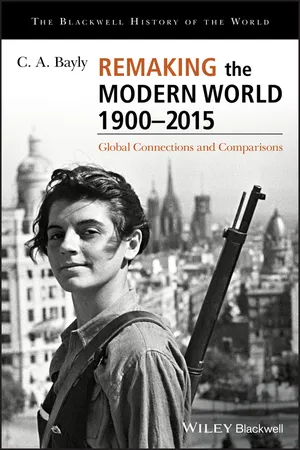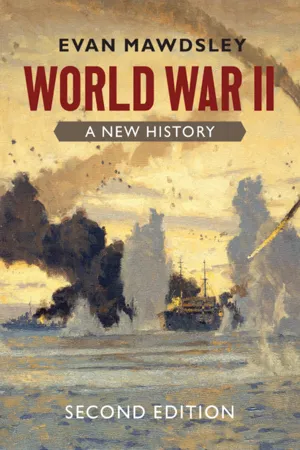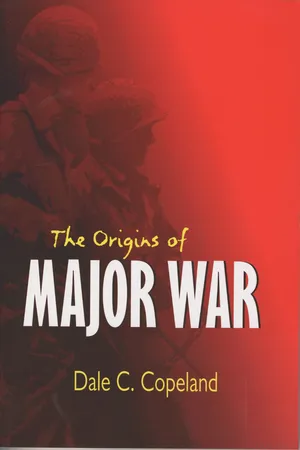History
Outbreak of WW2
The outbreak of World War II in 1939 was a global conflict that arose from the expansionist policies of Nazi Germany, led by Adolf Hitler, and the aggressive actions of Japan and Italy. The war involved most of the world's nations, divided into two opposing military alliances: the Allies and the Axis powers. It resulted in widespread destruction and loss of life, fundamentally reshaping the geopolitical landscape.
Written by Perlego with AI-assistance
Related key terms
1 of 5
5 Key excerpts on "Outbreak of WW2"
- No longer available |Learn more
- (Author)
- 2014(Publication Date)
- College Publishing House(Publisher)
________________________ WORLD TECHNOLOGIES ________________________ Chapter 5 World War II World War II , or the Second World War (often abbreviated as WWII or WW2 ), was a global military conflict lasting from 1939 to 1945, which involved most of the world's nations, including all of the great powers: eventually forming two opposing military alliances, the Allies and the Axis. It was the most widespread war in history, with more than 100 million military personnel mobilised. In a state of total war, the major participants placed their entire economic, industrial, and scientific capabilities at the service of the war effort, erasing the distinction between civilian and military resources. Marked by significant events involving the mass death of civilians, including the Holocaust and the only use of nuclear weapons in warfare, it was the deadliest conflict in human history, resulting in 50 million to over 70 million fatalities. The war is generally accepted to have begun on 1 September 1939, with the invasion of Poland by Germany and Slovakia, and subsequent declarations of war on Germany by France and most of the countries of the British Empire and Commonwealth. Germany set out to establish a large empire in Europe. During 1939 to early 1941, in a series of suc-cessful military campaigns and political treaties, Germany conquered or politically subdued most of continental Europe apart from the Soviet Union. Britain and the Commonwealth remained the only major force continuing the fight against the Axis in North Africa and in extensive naval warfare. In June 1941, the European Axis launched an invasion of the Soviet Union, giving a start to the largest land theatre of war in history, which, from this moment on, was tying down the major part of the Axis military power. - eBook - ePub
Remaking the Modern World 1900 - 2015
Global Connections and Comparisons
- C. A. Bayly(Author)
- 2018(Publication Date)
- Wiley-Blackwell(Publisher)
This was certainly one of the three most destructive and bloody encounters in history, killing perhaps 25 million soldiers and civilians. It dwarfed even the mortality of the Taiping Rebellion in nineteenth-century China, while exceeding fatalities in the First World War itself. In fact, as a global event, the Second World War touched more regions directly than the First World War and created a consciousness of fear and ideological conflict which was even more pervasive. 6 Above all, the war was coexistent with the Holocaust, the mass murder of European Jews by the Nazis, an event of such enormity that it forms the central act of Chapter 14. The scale of devastation and loss of life was one condition which made conceivable the use of atomic weapons against Japan in 1945. Still, it is helpful to consider a decentralised view of the Second World War, seeing it in Churchill's terms again as the climax of a second, and yet broader, world crisis which stretched from about 1935 to 1948 and continued to incite small wars well after that date. The conflict between heavily armed and increasingly nationalistic powers began with the Italian invasion of Ethiopia (Abyssinia) in 1935, the expansion of Japan's war against China from the Manchurian borderlands to mainland China in 1936 and the Spanish Civil War. The next phase of this second world crisis saw the war between Germany, France and Britain with the occupation of France in 1940. The third phase, beginning in late 1941 and 1942, was dominated by the German invasion of the USSR, the central event of the period, Japanese attacks in the Pacific and Southeast Asia and the entry of the United States into the war. The final phase saw the dropping of the atomic bomb, the American conquest of Japan and the Anglo-American reconquest of Southeast Asia - eBook - PDF
World Civilizations
Volume II: Since 1500
- Philip Adler, Randall Pouwels(Authors)
- 2017(Publication Date)
- Cengage Learning EMEA(Publisher)
After 1946 at the latest, neither side had any real interest in cooperating to establish world peace except on terms it could dictate. For an entire generation, the world and especially Europe would lie in the shadow thrown by the atomic mushroom, with the paralyzing knowledge that a struggle between the two superpowers meant a third, and final, world war. KEY TERMS Anschluss Axis Pact Battle of the Coral Sea Battle of Midway Island Berlin blockade D-Day Munich Agreements Nonaggression Pact of 1939 Operation Barbarossa Popular Front Second Front Stalingrad Yalta conference World War II came about through a series of aggressive steps taken by the fascist and Nazi dictatorships in the later 1930s against the defeatist and indecisive democratic states of Western Europe. Hitler quickly recognized the weakness of his opponents and rode his support by most Germans to a position of seeming invincibility in foreign affairs. The remilitarization of the Rhineland was followed by the annexation of Austria and Czechoslovakia, and finally the assault against Poland in September 1939, which began the general war. The battles in the first three years of war were mainly decided in favor of the Axis powers led by Germany, but the Battle of Stalingrad and the defeat of the Axis in North Africa marked a definite military turning point in the fall of 1942. In a long-range sense, the entry of the United States into the war following the Japanese attack on Hawai’i was the turning point, even though it took a full year for the Americans to make much difference on the fighting fronts. By late 1944, the writing was clearly on the wall for both the Germans and the Japanese, and attention turned to the postwar settlement with the Soviet ally. Despite some attempts, this settlement had not been spelled out in detail during the war because of the continuing mistrust between East and West. - eBook - PDF
World War II
A New History
- Evan Mawdsley(Author)
- 2020(Publication Date)
- Cambridge University Press(Publisher)
1 The World in 1937 T I M E L I N E 1919 Paris Peace Conference; Treaty of Versailles 1919 Creation of the Communist International (Comintern) 1921–2 Washington Conference on China and the Pacific 1927 Start of Soviet first Five-Year Plan 1929 Wall Street Crash (Great Depression begins) 1931 Mukden incident; Japan begins seizure of Manchuria 1933 NSDAP comes to power in Germany 1936 Anti-Comintern Pact between Germany and Japan 1937 Marco Polo Bridge incident; beginning of second Sino-Japanese War The Background to World War II This chapter looks at three interrelated questions. What was the relative strength – real and perceived – of the major powers at the end of the 1930s? What factors – economic, political, diplomatic, historical – led the governments of those states to enter the war? And what were the expectations about the nature of a future war? The two world wars developed very differently. World War I began with the ‘big bang’ of August 1914. Five great powers – Austria-Hungary, Germany, Russia, France, and the British Empire – all suddenly became involved in a general war. There is only one crisis for historians to consider. The assassination of Archduke Franz Ferdinand at Sarajevo can be seen as a causal event, and historians can debate the way in which the five powers managed or mismanaged the happenings of only a few weeks. What we think of as World War II, in contrast, did not begin with one burst of conflict. Japan and China went to war in July 1937 after the Marco Polo Bridge incident. A second war began in Europe two years later, in September 1939; Germany invaded Poland, and Britain and France declared war on Germany. Italy entered the conflict in May 1940 and extended the fighting into the Mediterranean. A whole year passed before Germany invaded the USSR and opened what was to be the bloodiest theatre of European conflict. Then it was six more months before Japan attacked Britain and the United States. - eBook - ePub
- Dale C. Copeland(Author)
- 2013(Publication Date)
- Cornell University Press(Publisher)
[5]
The Rise of Russia and the Outbreak of World War II
The Second World War in Europe is one of the most studied cases of major war in history, and its social, political, and moral aspects are so complex that to capture it in a short space risks oversimplifying one’s argument. The sheer horror of what Nazi Germany wrought in Europe is so overwhelming that to emphasize the security side of German policy, as I do below, seems to temper our conviction that this was one of the most evil regimes in history.Such tempering is not my objective. Rather, I seek to show that responsibility for the evil must also be put squarely on the shoulders of German military leaders. These leaders not only accepted Hitler’s long-term geopolitical objectives, but worked untiringly to bring about their realization. Yet by posing as unwilling participants in a Nazi Party conspiracy, the German military have managed for the most part to escape the ire of the western world.1 They have presented their occasional resistance to Hitler’s plans as evidence that they tried to stop the steamroller. As this chapter shows, however, almost all military resistance to Hitler’s plans in 1938-40 was driven by expedient, not moral, reasons: the generals felt Hitler was bringing on major war too soon, and so recommended delays or tactical adjustments to his strategic goals. After surprisingly easy victories from September 1939 to June 1940, all military “resistance” to Hitler mysteriously dried up. The generals were not coerced into submission; they merely now believed in Hitler’s strategic genius. Thus from July 1940 to June 1941 they fell with great enthusiasm into the most arduous task of all—the destruction of the Soviet Union.INTERPRETATIONS OF THE WAR
While literature on the origins of the European war overwhelmingly emphasizes Germany’s nonsecurity objectives, this chapter shows that fear of the rise of Russia was a primary and probably dominant force pushing Hitler and his generals to war. The causes of war in 1939 thus parallel those in 1914. German leaders continued to face a state with three times Germany’s population and forty times its land mass. Once Russia completed its industrialization and translated economic power into military power, they worried that Germany would be its first victim.2
Index pages curate the most relevant extracts from our library of academic textbooks. They’ve been created using an in-house natural language model (NLM), each adding context and meaning to key research topics.




